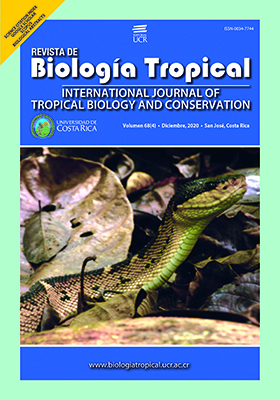Abstract
Introduction: Epiedaphic springtails participate in a wide variety of services linked to plant nutrient availability, water storage and regulation, soil stability and control of moisture and pH necessary for soil fertility. Therefore, epiedaphic springtails are sensitive to soil use change. Objective: To compare diversity of epiedaphic springtails in two types of introduced vegetation: pastures and forestations of Eucalyptus pellita in a region of the Colombian eastern plans. Methods: Springtails were collected from introduced pastures and young, middle and mature forested areas of E. pellita, using pitfall traps containing Propylene Glycol (40 %) as preservative, during one dry and one wet season. Alfa and Beta diversity were compared at genus level, and community composition was explained using a set of 14 environmental variables through a redundancy analysis (RDA). Results: Epiedaphic springtails were represented by Entomobryomorpha (62 %), Poduromorpha (17 %) and Symphypleona (21.1 %), 12 families and 26 genera. Effective number of Collembola genera was lower in plantations but abundance was different only in young plantations during dry season. The variables related to forest coverage, soil organic matter coverage and Nitrogen better explained the observed genera assemblage. Conclusions: Forest plantations allowed an assembly of springtails less diverse than in pastures; but comprised both types of genera, those proper of open areas and those from surrounding natural wooded areas.
##plugins.facebook.comentarios##

This work is licensed under a Creative Commons Attribution 4.0 International License.
Copyright (c) 2020 Dayssy Anyely Duarte Nuñez, Olga Patricia Pinzón Florián, José Guadalupe Palacios-Vargas







